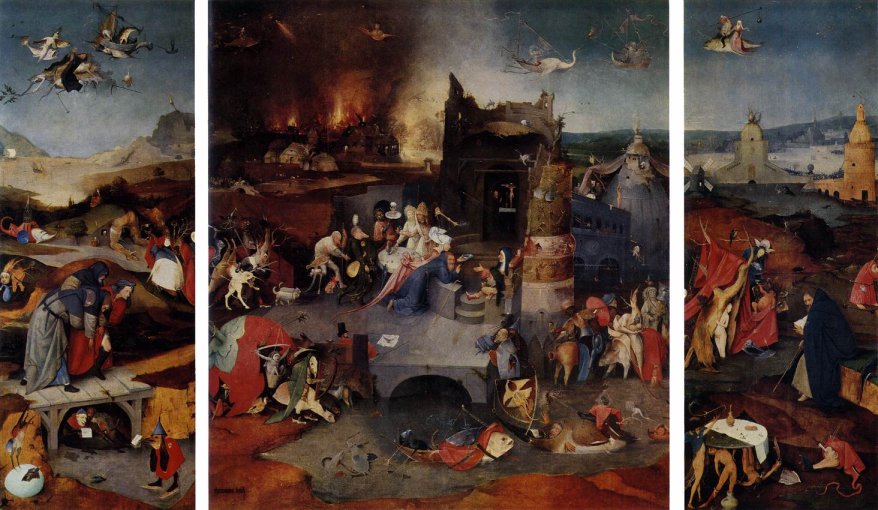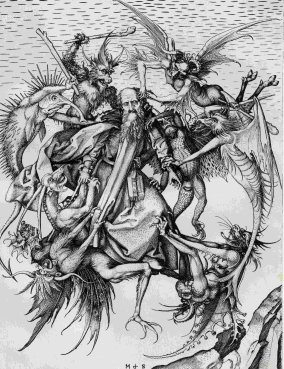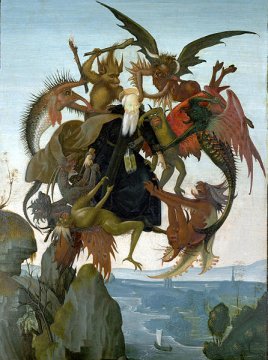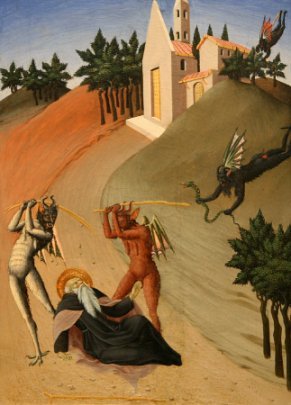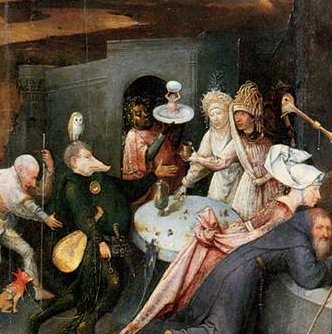|
Saint Anthony |
|
|
|
|
|
The best known images of St Anthony are entitled
'The Temptations of St Anthony'. Looking at them, one might be forgiven
for thinking that his situation looks anything but tempting. 'The
Torments of Anthony' might be a better title: the Devil's attempts to
tempt Anthony have failed, Anthony has slammed the door in his face, and he is very, very angry. As with the discussion on temptations, this is of course a simplistic view. Athanasius is writing metaphorically, trying to explain just how difficult it is to overcome temptation. Metaphor or not, artists have made most of it. Schongauer and Bosch are in their element here. |
|
|
|
|
|
|
|
|
'And after he had prayed, he said with a shout, Here am I, Anthony; I flee not from your stripes, for even if you inflict more nothing shall separate me from the love of Christ. And then he sang, “though a camp be set against me, my heart shall not be afraid.” These were the thoughts and words of this ascetic. But the enemy, who hates good, marvelling that after the blows he dared to return, called together his hounds and burst forth, “Ye see,” said he, “that neither by the spirit of lust nor by blows did we stay the man, but that he braves us, let us attack him in another fashion.” But changes of form for evil are easy for the devil, so in the night they made such a din that the whole of that place seemed to be shaken by an earthquake, and the demons as if breaking the four walls of the dwelling seemed to enter through them, coming in the likeness of beasts and creeping things. And the place was on a sudden filled with the forms of lions, bears, leopards, bulls, serpents, asps, scorpions, and wolves, and each of them was moving according to his nature. The lion was roaring, wishing to attack, the bull seeming to toss with its horns, the serpent writhing but unable to approach, and the wolf as it rushed on was restrained; altogether the noises of the apparitions, with their angry ragings, were dreadful. But Anthony, stricken and goaded by them, felt bodily pains severer still. He lay watching, however, with unshaken soul, groaning from bodily anguish; but his mind was clear, and as in mockery he said, “If there had been any power in you, it would have sufficed had one of you come, but since the Lord hath made you weak you attempt to terrify me by numbers: and a proof of your weakness is that you take the shapes of brute beasts.” And again with boldness he said, “If you are able, and have received power against me, delay not to attack; but if you are unable, why trouble me in vain? For faith in our Lord is a seal and a wall of safety to us.” So after many attempts they gnashed their teeth upon him, because they were mocking themselves rather than him.' (Athanasius chapter 8) |
|
|
|
|
|
For the modern viewer, these scenes may seem bizarre and even comic rather than frightening. Beliefs have changed, and unsophisticated twentieth century horror films of monsters and zombies are viewed with amusement rather than terror. It is probably now impossible to wind back to a fifteenth century candle-lit chapel and imagine the effect of these images on congregations, especially when they were coupled with appropriately apocalyptic preaching. |
|
|
|
|
|
|
|
|
'At last when the dragon could not even thus overthrow Anthony, but saw himself thrust out of his heart, gnashing his teeth as it is written, and as it were beside himself, he appeared to Anthony like a black boy, taking a visible shape in accordance with the colour of his mind. . . . But Anthony having given thanks to the Lord, with good courage said to him, “Thou art very despicable then, for thou art black-hearted and weak as a child. Henceforth I shall have no trouble from thee, "for the Lord is my helper, and I shall look down on mine enemies." Having heard this, the black one straightway fled, shuddering at the words and dreading any longer even to come near the man.' |
|
|
Click here for an Extended
text from Athanasius. |
|
|
|
|
